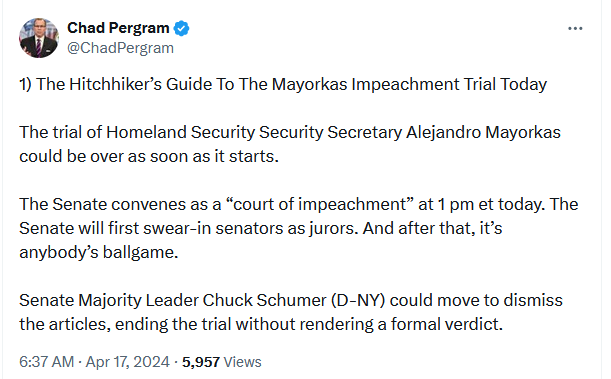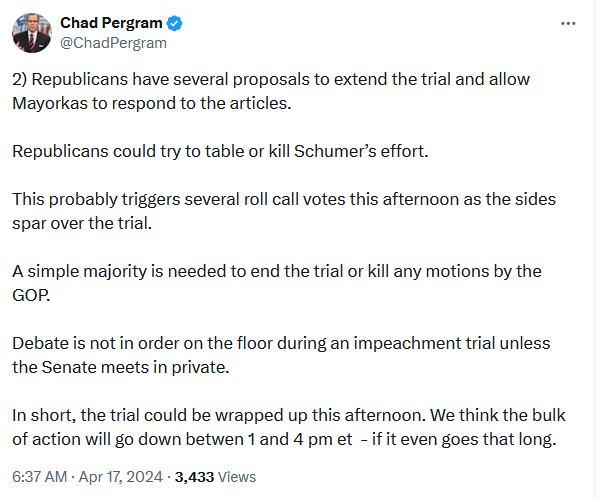Between the Einstein zoom, which was great fun, and the fundraising this afternoon, I didn’t have much time to check out the news today. So here’s some good news I found after the zoom.
Okay, I knew the Senate rejected the articles, but I loved the framing of this – Republicans trying to look solemn as they put on their farcical impeachment show. And then, bam, Schumer tossed them in the (virtual) garbage where they belonged.
The Senate rejected the articles of impeachment in less time than it took to walk them over to their chambers.
— Jack E. Smith ⚖️ (@7Veritas4) April 17, 2024
.
Just submitted an amendment to Bill drafting appointing MTG as Putin’s Special Envoy to the United States Congress. https://t.co/Gn8Dd3lZwj
— Jared Moskowitz (@JaredEMoskowitz) April 18, 2024
.
I am very happy about Secretary Yellen’s strong support, and that the House is planning to vote on my bipartisan REPO bill to seize those assets.https://t.co/ABuyNLDb8f
— Sheldon Whitehouse (@SenWhitehouse) April 17, 2024
.
The Senate rightly defeated the baseless Mayorkas impeachment that even conservative legal scholars said was unconstitutional.
Real solutions are on the table. Republicans should stop wasting time on political stunts, while killing bipartisan border reforms.
Full WH statement: pic.twitter.com/Do4iZTBSSW
— Ian Sams (@IanSams46) April 17, 2024
Janet Yellen’s Ukraine mission (Politico)
The Biden administration is making a new push this week to rally reluctant allies behind the idea that billions in immobilized Russian assets should be tapped to support Ukraine.
Treasury Secretary Janet Yellen will spend the coming days laying the groundwork as fellow finance ministers gather in Washington for the IMF-World Bank spring meetings. It’s expected to be an agenda item at Wednesday afternoon’s meeting of G7 finance leaders and in other discussions on the sidelines.
“Our goal is to try to get it done as soon as possible,” said a Treasury official granted anonymity. “And if that is this summer, that’s as soon as possible.”
The challenge for Yellen is two-fold. The idea is bipartisan but political resistance is emerging at home from a key ally of former President Donald Trump. The U.S. is also facing unease in Europe, where most of the assets are located. The U.S. Congress has struggled for months to agree on fresh aid to support Ukraine more than two years after Russia launched a full-scale invasion.Officials are considering a menu of options. They include seizing Russia’s sovereign assets outright as well as structuring a loan backed by windfall profits from the assets. The goal is to advance discussions so top G7 leaders can make a decision when they gather in June.
I am guessing that this isn’t literally true, but I suppose it is possible, seeng as it is Marge, after all.
MTG demands sharks with frickin laser beams on their heads to patrol the rio grande
— Angry Staffer 🌻 (@Angry_Staffer) April 18, 2024
Open thread.




